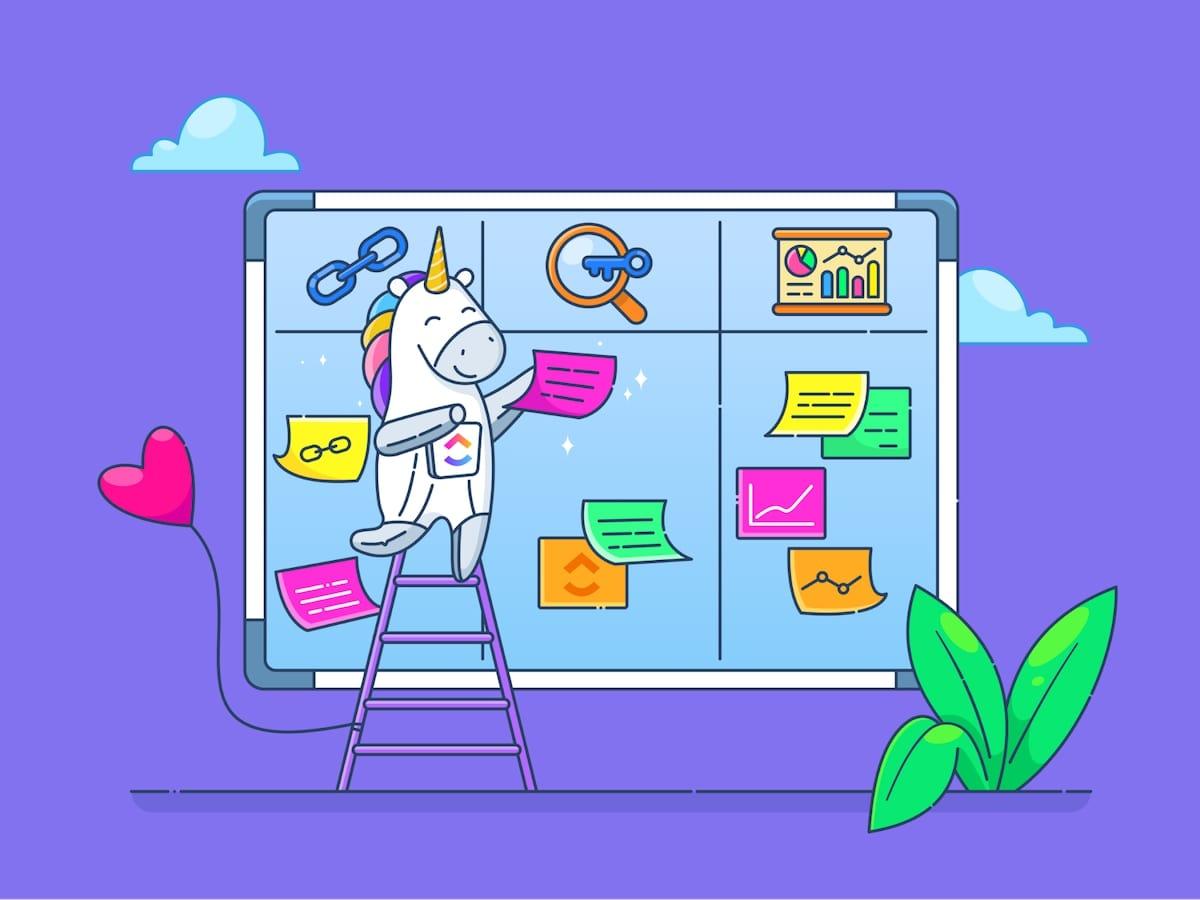تخيّل أن تخرج لقضاء يوم على الشاطئ، لتجد نفسك في عاصفة غير متوقعة.
ألم يكن من المفيد معرفة حالة الطقس مسبقاً؟
وبالمثل، عند الشروع في مشاريع جديدة، فإن وجود توقعات واضحة للنتائج المحتملة يمكن أن يكون الفرق بين النجاح والفشل. وهنا يأتي دور علم التنبؤ بالمشاريع.
تماماً كما يستخدم خبراء الأرصاد الجوية البيانات والأنماط للتنبؤ بالطقس، يستخدم مديرو المشاريع أدوات التنبؤ بالمشروع لتوقع مستقبل مهامهم. لا يساعدك فهم هذه النتائج المتوقعة على التخطيط بكفاءة فحسب، بل يساعدك أيضًا على تطوير استراتيجيات استباقية لتجاوز حالات عدم اليقين التي تنشأ حتمًا.
لا يتعلق التنبؤ بالمشروع بامتلاك كرة بلورية لرؤية المستقبل. بدلاً من ذلك، يتعلق الأمر بتزويد نفسك أو فريق مشروعك بالمعرفة والأدوات المناسبة للتكيف والازدهار وسط المجهول.
لذلك، دعنا نتعمق في هذا العلم الرائع ونتعلم كيف يمكن أن يكون سلاحك السري لنجاح المشروع.
ما هو التنبؤ بالمشروع؟
التنبؤ بالمشروع، أو التنبؤ بإدارة المشاريع، هو عندما تقوم بعمل تنبؤات أو افتراضات حول ما يحتمل حدوثه بناءً على البيانات والمعرفة والخبرة. أنت تتنبأ بالنتائج المحتملة لمشروعك.
هناك ثلاثة عناصر رئيسية يجب مراعاتها في التنبؤ بإدارة المشروع:
- المدة
- التكلفة
- الجودة
دعنا نستكشف مجالات التنبؤ بالمشروع هذه بمزيد من التفصيل.
المدة
العامل الأول الذي يجب مراعاته هو مدة المشروع، أو المدة التي سيستغرقها المشروع. إن معرفة المدة التي قد يستغرقها المشروع يعني أنه يمكنك تخطيط الموارد بفعالية. بالإضافة إلى ذلك، يمكنك أن تعطي عميلك أو جهة الاتصال الداخلية تقديراً جيداً لموعد اكتمال المشروع. ⌚
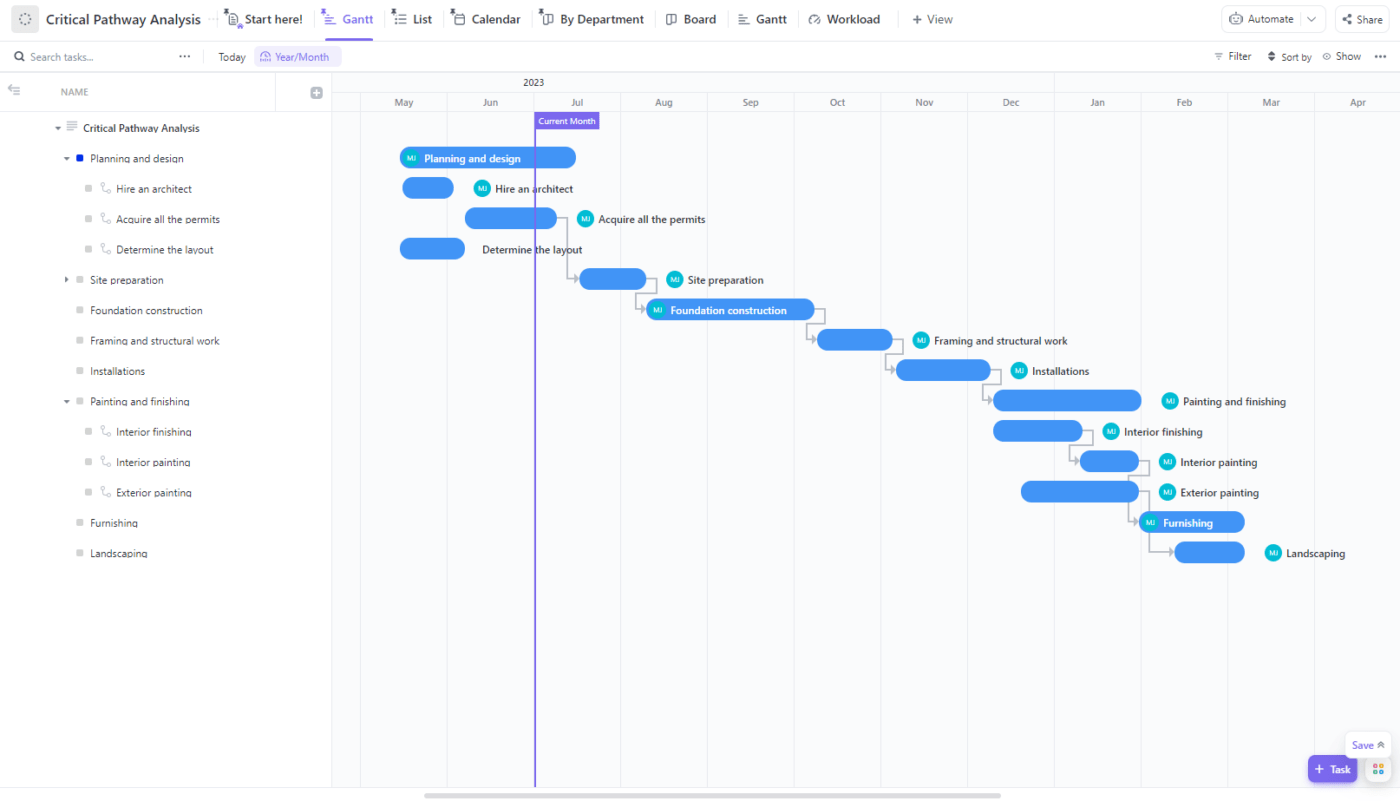
اجعل الجدول الزمني لمشروعك أسهل في الفهم باستخدام مخطط شبكي أو مخطط جانت الخاص بـ ClickUp أو أي طريقة أخرى
اكتشف المدة التي يجب أن يستغرقها المشروع بناءً على التكرارات السابقة أو معرفتك الخاصة أو خبراتك المشتركة أو عن طريق سؤال أعضاء الفريق الآخرين. من هناك، قم بتقسيم المشروع إلى عناصر أو مجموعات مهام أصغر حتى تتمكن من مراقبة وإدارة الوقت بشكل أكثر فعالية وإنشاء جدول زمني دقيق جدول زمني دقيق للمشروع .
من الطرق الرائعة للقيام بذلك استخدام أداة مخصصة لإدارة المشروع. يساعدك هذا على فهم أين أنت نحو نجاح المشروع بشكل عام الذي قمت بتنفيذه لأول مرة.
تكلفة المشروع
بمجرد أن تحدد فكرة تقريبية عن المدة التي ستستغرقها مهمتك أو مشروعك، عليك التفكير في التكلفة. إن القدرة على التنبؤ بدقة أو التنبؤ بتكلفة المشروع يعني أنه يمكنك وضع ميزانية أكثر فعالية وتجنب الحاجة إلى العودة إلى عميلك لطلب أموال إضافية أو تحمل الخسائر والتأثير على ربحيتك. 💰

من السهل إضافة قيم مالية إلى المهام لإبقاء ميزانيات المشاريع على المسار الصحيح
ضع في اعتبارك جميع الموارد التي يحتاجها مشروعك وتكاليفها الحقيقية. وهذا يشمل الموظفين والمقاولين والمواد والأدوات. استخدم البيانات التاريخية المتوفرة لديك لبناء ميزانية دقيقة ميزانية المشروع ، ثم راقب النفقات لإبقاء تكاليفك قريبة من ميزانيتك المتوقعة قدر الإمكان.
الجودة
المجال الأخير الذي يجب مراعاته هو الجودة. نريد جميعًا أن يكون كل مشروع نكمله على أفضل ما يكون، ولكن في بعض الأحيان تعني القيود مثل التوقيت أو الميزانية أو الموارد أننا بحاجة إلى إجراء تعديلات في مكان ما.
يتيح لك فهم الجودة المحتملة لمشروعك النهائي أن تكون شفافًا مع العملاء حول مكان أولوياتك في الهدف النهائي المتمثل في الوصول إلى نجاح المشروع. ✔️
يحتاج مديرو المشاريع إلى التفكير فيما إذا كان هذا مشروعًا يجب الحفاظ على جودته بأي ثمن أو ما إذا كانوا سيحتاجون إلى توفير المال على المواد أو المقاولين لإعطاء الأولوية لإنجاز المشروع في موعد نهائي صارم بدلاً من ذلك.
للقيام بذلك، ستحتاج إلى فكرة جيدة عن مجموعة متنوعة من المواد والموارد التي يمكنك الوصول إليها، وتكلفتها، ومتى ستكون متاحة.
## أهمية التنبؤ بالمشروع في إدارة المشاريع
يمنحك التنبؤ بالمشروع فكرة أوضح عن التحديات التي قد تواجهها على طول الطريق، حتى تتمكن من التخطيط للمستقبل وجعل تقديم مشروع ناجح في الوقت المحدد وفي حدود الميزانية حقيقة واقعة.
تشمل الفوائد الأخرى لاستخدام أساليب التنبؤ في إدارة المشاريع ما يلي:
- إعطاء المزيد من الوضوح لأعضاء الفريق والمقاولين والعملاء
- التنبؤ بالنتائج المحتملة المختلفة بناءً على نقاط القرار الرئيسية
- النظر في الاحتمالات المحتملةمخاطر المشروع واتخاذ خطوات للحد منها
- القدرة على بناء أفضل فريق عمل ممكن
- التخطيط للتحديات أو العوائق المحتملة بناءً على التجارب السابقة
- الاستجابة بسرعة وثقة للمشاكل غير المتوقعة
- تسليم المشاريع في أقرب وقت ممكننطاق المشروع
- زيادة فرصة أن يفي مشروعك بالمواعيد النهائية ويعتبر ناجحًا
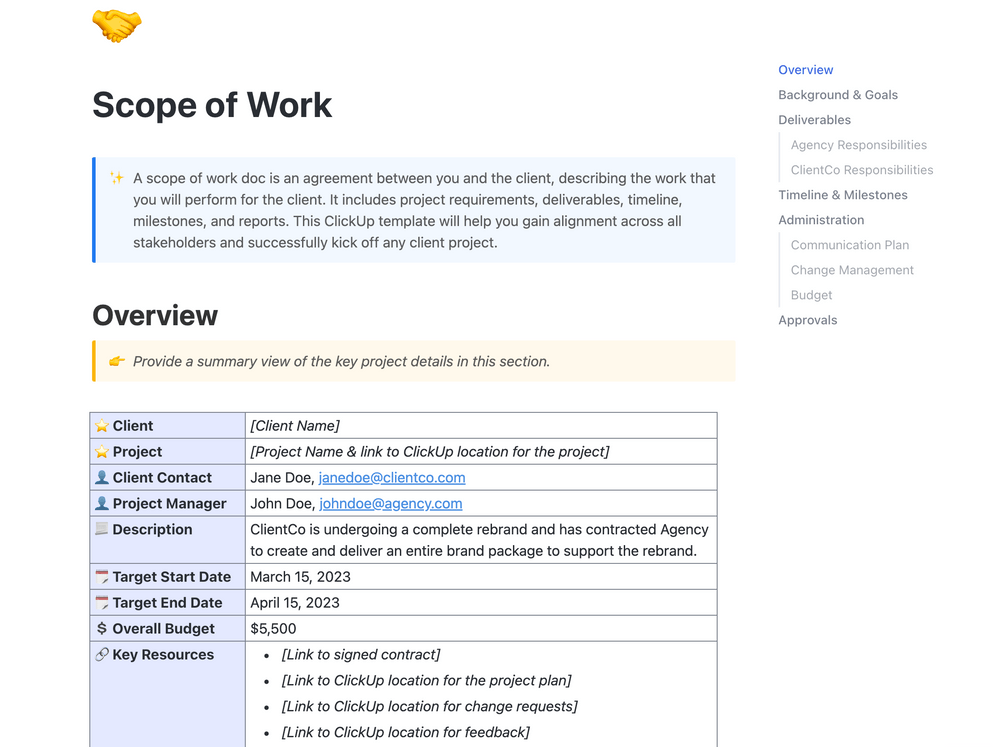
يمكن أن يساعدك قالب ClickUp نطاق العمل على تحديد جميع تفاصيل المشروع
قد يستغرق التنبؤ بإدارة المشروع وقتًا ثمينًا، لكنه بالتأكيد يستحق ذلك. فبدون توقعات المشروع (أو توقعات متعددة) لن يكون لديك أي فكرة عن المدة التي قد يستغرقها المشروع، أو الموارد التي ستحتاجها، أو ما هي النتيجة النهائية التي قد تكون عليها.
مع وجود توقعات دقيقة، يكون لدى فريقك وعميلك النهائي رؤية واضحة للمتطلبات والنتائج المتوقعة.
مثال على التنبؤ بإدارة المشاريع في الممارسة العملية
إن فهم أهمية التنبؤ بالمشروع ومعرفة كيفية وضعه موضع التنفيذ أمران مختلفان. فيما يلي مثال على التنبؤ بإدارة المشاريع عمليًا حتى تتمكن من رؤية ما ينطوي عليه الأمر.
اتصل أحد العملاء بشركتك وطلب منك العمل معه في مشروع بناء تجاري جديد. لقد عملتم معًا من قبل، لذا فأنت تعلم أن جودة المشروع بالنسبة لهم مهمة للغاية - وأنهم سعداء باستثمار المزيد من الميزانية للحصول على أفضل فريق عمل ممكن في المشروع. 👷
بناء خطة التنبؤ الخاصة بك
بعد أن تكون قد أخذت جميع المعلومات الأساسية لإنشاء ضوابط المشروع ، ستحتاج إلى بناء توقعات مشروعك.
للقيام بذلك، ضع في اعتبارك:
- ما الذي يتضمنه المشروع: اطلب من عميلك موجزاً شاملاً واعمل على وضع استراتيجية تتحقق من جميع المربعات التي يريدها، بما في ذلك التحقيق في المواقع المحتملة، والتوصية بالمواد الصديقة للبيئة، وإدارة المقاولين في الموقع
- من هم أعضاء الفريق الذين ستقوم بتعيينهم للمشروع: حاول تعيين مدير المشروع وفريق العمل المفضلين لدى عميلك إن استطعت، واستكملهم بأفضل الأشخاص لديك للقيام بمهام أو أدوار محددة
- المدة التي ستستغرقها كل خطوة من المشروع: قسّم مشروعك إلى أقسام، واستخدم خبرة فريقك للتنبؤ بالمدة التي سيستغرقها كل قسم. استخدم هذا لبناءالجدول الزمني للمشروع يمنحك رؤية واضحة للعملية بأكملها.
- ما ينبغي أن تكون ميزانيتك: بناءً على ما سبق، ناقش ميزانية المشروع والتكاليف المحتملة مع العميل. اعرض عليه خيارات التسعير المحتملة واطلب منه الموافقة على ميزانية محددة، مع تخصيص مخصص للإنفاق الزائد المحتمل

قم بتعيين ترتيب واضح للعمليات من خلال إضافة تبعيات "الحظر" أو "الانتظار" بين المهام وإبقاء فريقك على المسار الصحيح لمعرفة ما يجب العمل عليه أولاً
هذه ليست كل الخطوات التي تنطوي عليها إدارة المشروع بنجاح، ولكنها ما تحتاجه لإنشاء توقعات دقيقة للمشروع. بعد اكتمال توقعاتك، يمكنك بعد ذلك مشاركتها مع عميلك لإنشاء عملية أكثر شفافية.
10 من أفضل 10 نصائح للتنبؤ بالمشروع لفرق المشروع
استخدم هذه النصائح الخبيرة في إدارة المشاريع للتنبؤ بالمشروع في المرة القادمة التي تحتاج فيها إلى فهم المسار المستقبلي للمشروع.
1. تحديد أهداف المشروع
كجزء من عملية تخطيط المشروع، ضع أهدافًا ذكية (SMART). ضع أهدافًا لنتائج المشروع تكون محددة وقابلة للقياس وقابلة للتحقيق وذات صلة ومحددة زمنيًا. لن تكون أهدافك أكثر تركيزًا فحسب، بل ستعرف أيضًا المقاييس التي يجب تتبعها من خلالها.
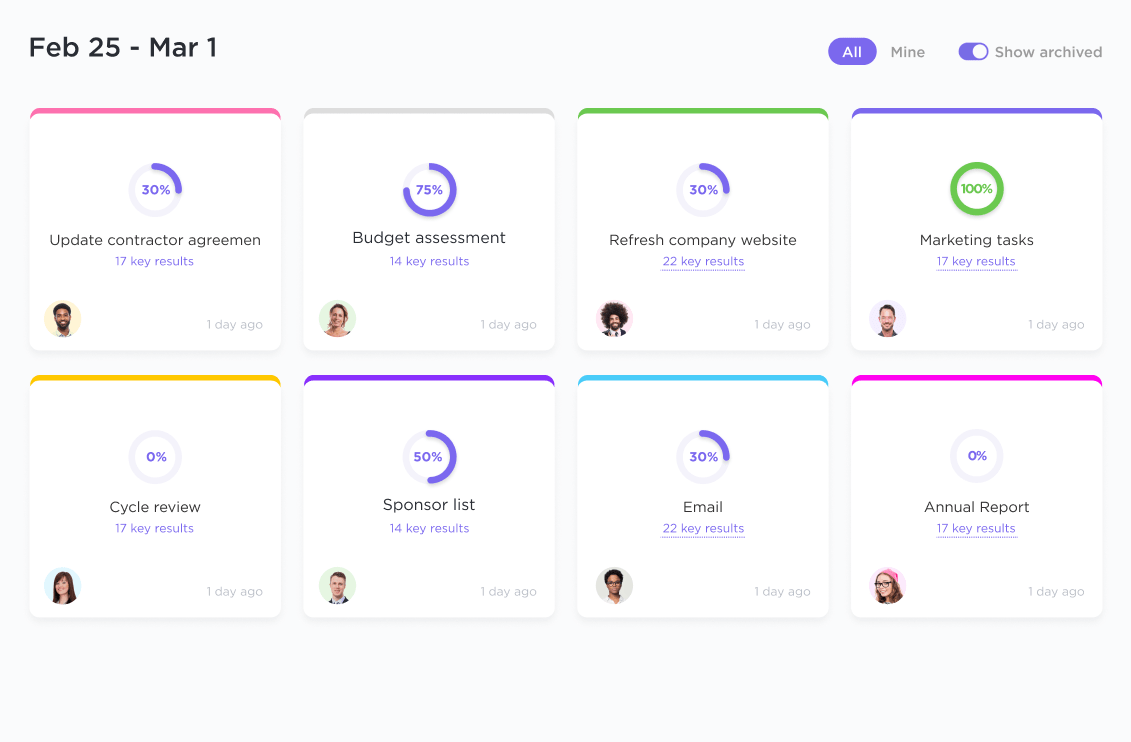
تتبع أهدافك وصولاً إلى مؤشرات الأداء الرئيسية الأكثر أهمية واحصل تلقائيًا على عروض مفصلة عن تقدمك
استخدم تطبيق تتبع الأهداف مثل أهداف النقر لتحديد أهدافك وتعيينها وتتبعها والاحتفال بتحقيقها. بمجرد أن يكون لديك أهداف محددة، يمكنك استخدامها لتوجيه عملية التنبؤ بمشروعك. تتيح لك معرفة أنك تريد تحقيق X بحلول التاريخ Y العمل بشكل عكسي لبناء إطار زمني واقعي، ثم تقدير مدى توافر الموارد والتكاليف المحتملة. 🎯
2. مراجعة البيانات التاريخية
للتنبؤ الدقيق بالمشروع، تحتاج بشكل مثالي إلى استخدام بيانات المشروع الحقيقية. وأفضل مكان للعثور عليها هو عملك السابق في مشاريع مماثلة أو من خلال البيانات التي تحتفظ بها الشركة بشكل عام حول الموارد أو المهام أو التكاليف.
باستخدام البيانات الصحيحة، تصبح تنبؤاتك أكثر دقة على الفور. إذا كان هذا مشروعًا جديدًا تمامًا، فقد لا يكون لديك الكثير من البيانات التي يمكنك استخدامها لإبلاغ تنبؤاتك. إذا كانت هذه هي الحالة، فابحث عما إذا كان بإمكانك جمع رؤى من فرق أخرى أو نتائج مشاريع أخرى في مجال تخصصك. 📈
3. إنشاء تنبؤات متعددة
من المغري أن ترغب في تقديم تنبؤ واحد صحيح يمكنك أن تضعه من كل قلبك. في الواقع، هذا ليس هو الحال في كثير من الأحيان، وتقديم تنبؤات متعددة هو في الواقع طريقة رائعة لإظهار خبرتك.
قم بإنشاء تنبؤات متعددة تأخذ في الاعتبار نتائج محتملة مختلفة مع تقديرات تكلفة مختلفة قليلاً، والتسليمات، والأطر الزمنية، وفرق المشروع بناءً على ما هو متاح. إن وجود أكثر من طريقة محتملة للمضي قدمًا يقدم لك خيارات عندما تواجه عائقًا ويظهر للعملاء أنك تؤمن بوجود أكثر من طريقة واحدة لتحقيق نتيجة ناجحة. 📊
4. تتبع وقتك
أن تكون قادرًا على تقديم جدول زمني واقعي لمشاريعك يبدأ بفهمك أولاً المدة التي تستغرقها كل مهمة. هذه خطوة حاسمة في التنبؤ بالمشروع.
استخدم تتبع وقت المشروع في ClickUp للحصول على رؤية دقيقة للمدة التي تستغرقها كل مهمة أو نشاط مشروع بالفعل. تتبع وقتك وحدد التقديرات واطلع على التقارير التي تبرز كيف يقضي أعضاء فريقك وقتهم.
![]()
تتبع الوقت، ووضع التقديرات، وإضافة الملاحظات، وعرض تقارير عن وقتك من أي مكان باستخدام المؤقت العالمي في ClickUp
إذا كنت تتطلع إلى زيادة إنتاجية فريقك، يمكنك الاستفادة من تقنيات إدارة الوقت واستخدم قوالب إدارة الوقت لتقليل الوقت الضائع والعمل بشكل أكثر فعالية. ⏰
5. إتاحة الوقت لتجاوز المهام
بينما يمنحك تتبع الوقت الذي تستغرقه في تتبع وقتك رؤية عن المدة التي يستغرقها كل نشاط بالفعل، لا يمكنك أن تبني كل قرار على أن كل تكرار لتلك المهمة يستغرق نفس الوقت. وبدلاً من ذلك، اسمح بوقت في مدة مشروعك للأنشطة التي تتجاوز الوقت المتوقع.
إن منح فريقك بعض المساحة لالتقاط الأنفاس يعني أن بإمكانهم العمل بوتيرة متسقة والقيام بأفضل ما لديهم، دون الضغط عليهم لإكمال كل مهمة كما لو لم يكن هناك شيء آخر على قائمة مهامهم. هذا الوقت الإضافي يعني أيضًا أنه من المرجح أن تبقى على المسار الصحيح مع الجدول الزمني لمشروعك ويمكنك إبلاغ عملائك بحالة "في الوقت المحدد". ✅
6. كن خبيرًا في إدارة الموارد
من الصعب التخطيط لموارد مشروعك إذا لم يكن لديك فهم جيد للأشخاص وإدارة الموارد. أنت بحاجة إلى فهم مدى توافر الموارد والتكاليف والجدولة وإدارة الأفراد لإنشاء توقعات المشروع الأكثر دقة.
يعد تخصيص الموارد والتنبؤ بها جزءًا أساسيًا من إدارة الموارد لذا فهي مهارة تستحق التطوير. بمجرد أن تتمكن من النظر في نقاط قوة أعضاء فريقك ومهاراتهم وجداولهم الزمنية وإجازاتهم المحتملة أو فترات الإرهاق المحتملة، يمكنك عندئذٍ بناء تنبؤات تعكس التأثير الحقيقي لكل موهبة فريدة في فريقك.
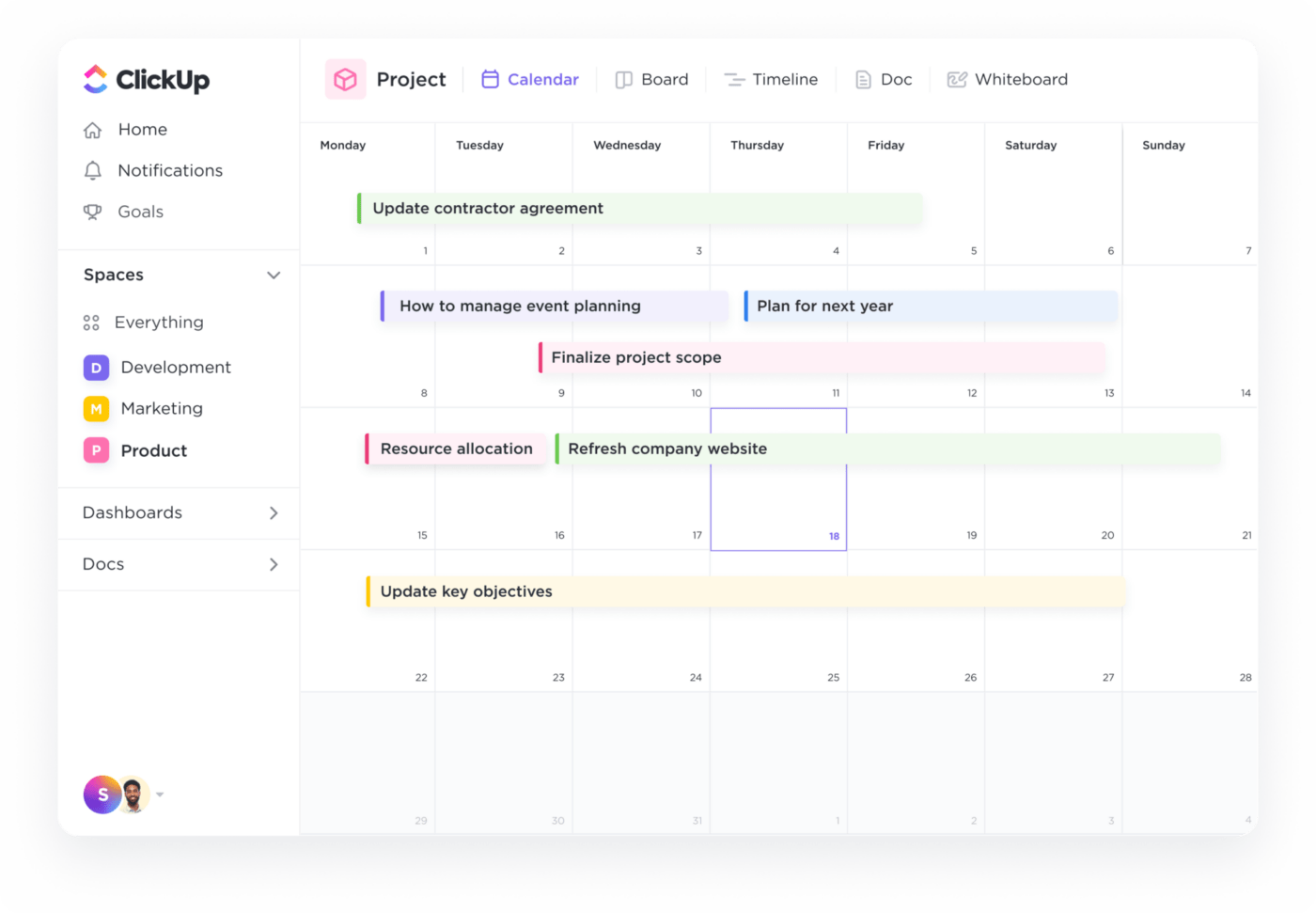
استخدم طريقة عرض تقويم ClickUp للاطلاع على مهامك حسب الأسبوع والشهر
استخدم عرض تقويم ClickUp لتصور مدى توافر فريقك وعبء العمل في لمحة سريعة. قم ببناء جداول زمنية قوية متوقعة بناءً على مدى توافرهم، وشاهد مهام المشروع والجداول الزمنية والمساحة غير المستخدمة المحتملة عبر عرض أسبوع أو شهر. 📅
7. إعادة النظر في توقعات مشروعك المبكرة
توقعات مشروعك ليست ثابتة - في الواقع، من الحكمة أن تعيد النظر فيها مع تقدم مشروعك إلى ما بعد المراحل الأولية. إن التحقق من توقعاتك على مدار المشروع بأكمله يعني أنه يمكنك التصرف بشكل استباقي إذا لاحظت أنك تنحرف عن المسار الصحيح.
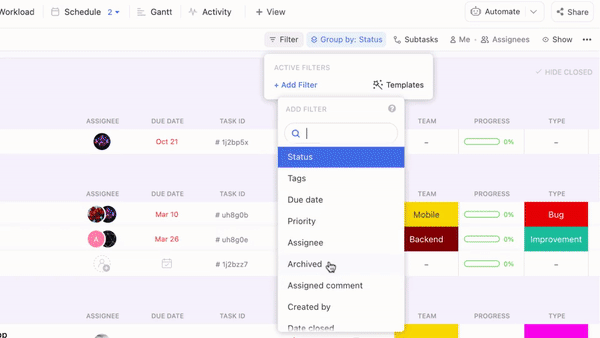
حدد النقاط المهمة لمشروعك بسهولة باستخدام معالم ClickUp Milestones واستخدم الرموز الماسية العريضة للحفاظ على تركيز الجميع على الأهداف الرئيسية
قم ببناء المعالم الرئيسية في عملية التنبؤ الخاصة بك ووافق على التحقق في النقاط الرئيسية لمراقبة التقدم المحرز. حدد ما إذا كان مسارك الحالي لا يزال يتماشى مع توقعاتك الأكثر احتمالاً أو ما إذا كان قد بدأ ينحرف نحو مسار آخر. 📝
8. شارك توقعات مشروعك مع الآخرين
من المفيد دائمًا أن يكون لديك وعي داخلي بالنتائج المحتملة لمشروعك ومساراته المستقبلية أمر مفيد، ولكن الأمر الأكثر تأثيرًا هو مشاركة ذلك مع الآخرين. لا تحتفظ بتوقعات مشروعك سراً، بل شاركها مع أصحاب المصلحة وفريق المشروع الأوسع نطاقاً كجزء من تقارير المشروع حتى يعرفوا ما يحدث.
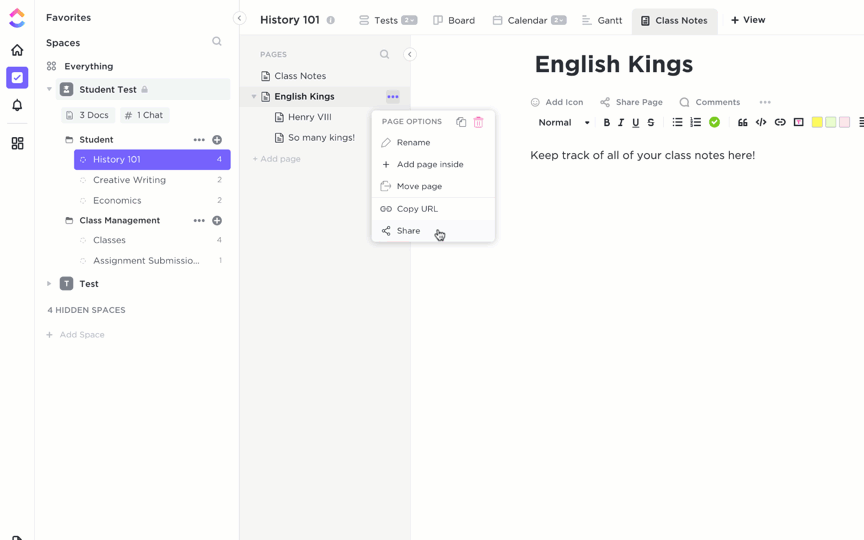
إنشاء تقارير مشروعك بشكل تعاوني في ClickUp Docs ثم مشاركتها مع أصحاب المصلحة الداخليين والخارجيين
مثل جميع مجالات إدارة المشاريع، فإن الانفتاح والشفافية يحسّن من أداء الفريق و التواصل مع العميل والثقة. شارك توقعاتك وتنبؤاتك مع أصحاب المصلحة حتى يشعروا بمزيد من الثقة في قدرتك ليس فقط على الإنجاز ولكن أيضًا على مراقبة التغيير واتخاذ الإجراءات عند الحاجة. 🙌
9. استخدم أدوات التنبؤ بالمشروع
يحتاج كل فريق عمل قوي إلى برنامج إدارة المشاريع لتعزيز مهاراتهم وتبسيط المهام المتعلقة بإدارة المشاريع الناجحة. استثمر في البرامج التي لا تسمح لك بإدارة المشاريع فحسب، بل والتنبؤ بها أيضًا، مثل ClickUp.
برنامج ClickUp مليء بالميزات المصممة لفرق المشاريع والتنبؤ بها. استخدم مهام ClickUp لإدارة قائمة المهام وأنشطة المشروع الخاصة بك، وعلى المشروع بأكمله من البداية إلى النهاية باستخدام انقر فوق إدارة المشاريع .
عرض وتتبع تقديرات الوقت في مهام ClickUp بسهولة لإدارة الموارد بشكل أفضل
وضع التوقعات وفهم المدة الزمنية التي تستغرقها كل مهمة مع تقديرات وقت النقر فوق . استخدم قالب إدارة البرنامج أو قالب جدول المشروع من ClickUp لإنشاء جدول زمني مرئي لتتبع تقدمك. ابق على اتصال مع أعضاء الفريق في الوقت الفعلي مع ClickUp Chat واستخدم ClickUp Dashboards لتصور تقدمك عبر مشاريع متعددة في وقت واحد. ⚒️
10. تقييم دقة توقعاتك
عند اكتمال المشروع، من أفضل الممارسات مقارنة ما حدث بالفعل بتقديراتك الأصلية. وهذا يمنح فريقك وأصحاب المصلحة نقطة مرجعية ومقارنة مفيدة ويسمح لك بتحديد الفرص المتاحة لتحسين توقعاتك أو سير العمل في المستقبل.
قيّم أداء مشروعك وقارنه بتوقعاتك التقديرية. حدد ما إذا كنت قد حققت أهدافك، وما إذا كانت الجداول الزمنية الخاصة بك قد تراجعت، وما إذا كنت قد أنجزت المشروع مقابل الميزانية المحددة.
استخدم هذه البيانات الجديدة لتبسيط سير العمل وتقديم كفاءات العملية وتحسين دقة توقعاتك المستقبلية. 👀
حسِّن نجاح مشروعك باستخدام تقنيات التنبؤ بإدارة المشاريع
تسمح التنبؤات الدقيقة للمشروع لفريقك بالعمل بأفضل ما لديهم دون ضغوط غير ضرورية، كما تسمح لعملائك وأصحاب المصلحة بفهم ما يمكن أن يحدث خلال الجدول الزمني لمشروعك. استخدم النصائح المذكورة أعلاه لتحسين نهجك في التنبؤ بإدارة المشاريع، حتى تتمكن من تقديم تنبؤات للمشاريع المستقبلية تكون دقيقة ومدعومة بالبيانات واستراتيجية.
إذا كنت تبحث عن أداة لا تجعل التنبؤ بالمشروع أسهل فحسب، بل يمكنها أيضًا تبسيط عملية إدارة المشروع بالكامل, جرّب ClickUp مجاناً . توفر منصتنا لفرق المشاريع مزيجًا لا يُضاهى من الميزات التي لا تُضاهى لإدارة المشاريع والمهام والموارد. ✨
